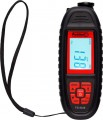Max. error
The maximum measurement error provided by the device, in other words, the largest deviation from the real value of the measured value that may occur during the measurement process. The smaller this indicator, the more accurate the device, the smaller the error it gives in the measurement process; on the other hand, high accuracy has a corresponding effect on cost.
Specifically, in thickness gauges, an accuracy of 10% is considered low, 5% is average, 3% is good, and less than 3% is excellent.
Auto switch-off
The presence in the device of the
automatic shutdown function: the device turns off on its own if the user has not performed any actions with it for some time. The response time for this function is usually a few minutes.
Auto-off saves battery power; it is especially useful if the user forgets to turn off the instrument manually.
LED light
The presence in the device of its own
LED flashlight. The power of such a light source is usually low and it is intended mainly to illuminate the measurement site — for example, if it is shaded and dimly lit. Although, of course, a flashlight can also be useful for general lighting at dusk / darkness.
UV bill detector
The presence of a built-in source of ultraviolet radiation in the device — usually in the form of a special LED. In accordance with the name, such an LED is mainly used as
a bill detector : most modern currencies have protective elements that glow in ultraviolet light, and under UV lighting, marks and inscriptions made by special “invisible” compositions become visible. There are other, more specific ways to use such a detector — for example, searching for leaks in air conditioners and refrigerators (many freons have additives that glow in the ultraviolet).
Built-in memory
Presence in the device of own
built — in memory. Such a memory is used to save the measurement results — this is often more convenient than writing them down manually or memorizing them. At the same time, the number of saved results in some models can reach several thousand (see "Recording (measurements)").
Operating temperature
The temperature range at which the thickness gauge can normally perform its functions. If you go beyond this range, the device may not break down immediately, but you won’t have to talk about accurate measurements. Note that you have to pay attention to this parameter mainly in cases where the device is planned to be used outdoors. So, for use in winter, it is worth making sure that the device is able to operate at
temperatures below zero, and for hot climates, it is desirable that the upper limit of the range is
+40 °C and above.

